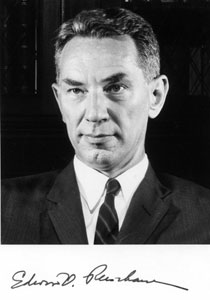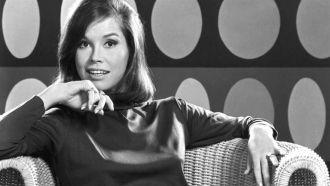Edwin O. Reischauer
Edwin Oldfather Reischauer (1910 Japan - 1990 California), Asian Scholar & U.S. Ambassador to Japan appointed by President Kennedy was the first Japanese-born and Japanese-speaking U.S. Ambassador to Japan (1961-1966). Through his mother, he was a descendant of three of the pioneers of Rice's Fort, Donegal Twp., Washington Co., PA: Heinrich Vollenweider (Henry Fullenwider), Jacob Rice (Reis), and Jacob Leffler.
His parents were Rev. August Karl Reischauer and Helen Sidwell Oldfather, Presbyterian educational missionaries in Japan. August was a professor at Meiji Gakuin University in Tokyo and helped found Tokyo Women's Christian College. Helen founded the Japan School for the Deaf.
Edwin had an older brother, Robert Karl Reischaurer, who was accidentally killed in Shanghai in 1937 when the Chinese planes attacking Japanese warships accidentally hit his hotel. He died from blood loss because of inadequate medical care. Edwin also had a sister Felicia, who, according to August's obituary, was unmarried and living near him in Massachusetts in their older years.
Edwin was raised in Japan and attended the American School in Tokyo, then attended Oberlin College in Ohio. Afterwards he went to Harvard, where he later taught. He was not only a scholar of Japanese language and culture, but also of Chinese and Korean.
He married first, in 1935, Adrienne Danton, an American raised in China, and also a scholar. They had three children, Ann; Robert Danton, and Joan. His biography is "My Life Between Japan & America."
Adrienne died in 1955. In 1956 Edwin married Haru Matsutaka, a Japanese journalist and descendant of eminent Japanese families.
Japan's First Class Order of the Rising Sun was conferred on him in 1968 for his work to promote better understanding between cultures. His list of honorary degrees includes recognition from Harvard, Yale, Oberlin, Michigan, Chicago, Brandeis, Dennison, and the Japanese universities of Nihon, Rikkyo, and Keio. In 1988 he received the American Historical Association's Award for Scholarly Distinction.
Dr. Reischauer's contributions to his field include his most recent books: The Japanese Today: Change and Continuity and My Life Between Japan and America: Memoirs. His readable history, Japan: The Story of a Nation, was an expanded follow-up of a previous work, Japan, Past and Present. He also wrote two detailed studies of the T'ang Dynasty in China: Ennin's Diary: The Record of a Pilgrimage to China in Search of the Law and Ennin's Travels in T'ang Japanese Literature. He has authored several books on U.S. policy, including Toward the Twenty-first Century: Education for a Changing World; Beyond Vietnam: The United States and Asia; and Wanted: An Asian Policy.
After serving as Ambassador. Reischauer returned to Harvard where he taught history until his retirement in 1981. During this period he wrote and re-wrote many of his books. "Japan: The Story of a Nation" (first edition 1970) is a widely-used text In American universities, and "The Japanese" (first edition 1977) is considered to be Reischauer’s definitive work. The Japanese, which he revised and re-titled two years ago as "The Japanese Today: Change and Continuity" (1988), is perhaps the best single-volume work on Japan.
Upon learning of Edwin Reischauer’s death, Prime Minister Toshiki Kaifu, Sony Chairman Akio Morita, former colleague Sen Nishiyama and many other Japanese leaders publicly expressed their condolences. One man wrote in a “letter to the editor” of the Mainichi Shinbun that “though he (Reischauer) was an American, he had the bushido spirit,.. the Japanese way of chivalry, well above the Japanese standard.” Another man wrote in the Sankei Shimbun that he had read “The Japanese” four times. And everything I’ve learned about Jaapanese history is thanks to E. O. Reischauer. He added, I wonder if there a new bridge between Japan and America? Or are Japan America relations strong enough so that a new bridge is unnecessary? A good question. John Van Sant
People in photo include: Edwin O. Reischauer
His parents were Rev. August Karl Reischauer and Helen Sidwell Oldfather, Presbyterian educational missionaries in Japan. August was a professor at Meiji Gakuin University in Tokyo and helped found Tokyo Women's Christian College. Helen founded the Japan School for the Deaf.
Edwin had an older brother, Robert Karl Reischaurer, who was accidentally killed in Shanghai in 1937 when the Chinese planes attacking Japanese warships accidentally hit his hotel. He died from blood loss because of inadequate medical care. Edwin also had a sister Felicia, who, according to August's obituary, was unmarried and living near him in Massachusetts in their older years.
Edwin was raised in Japan and attended the American School in Tokyo, then attended Oberlin College in Ohio. Afterwards he went to Harvard, where he later taught. He was not only a scholar of Japanese language and culture, but also of Chinese and Korean.
He married first, in 1935, Adrienne Danton, an American raised in China, and also a scholar. They had three children, Ann; Robert Danton, and Joan. His biography is "My Life Between Japan & America."
Adrienne died in 1955. In 1956 Edwin married Haru Matsutaka, a Japanese journalist and descendant of eminent Japanese families.
Japan's First Class Order of the Rising Sun was conferred on him in 1968 for his work to promote better understanding between cultures. His list of honorary degrees includes recognition from Harvard, Yale, Oberlin, Michigan, Chicago, Brandeis, Dennison, and the Japanese universities of Nihon, Rikkyo, and Keio. In 1988 he received the American Historical Association's Award for Scholarly Distinction.
Dr. Reischauer's contributions to his field include his most recent books: The Japanese Today: Change and Continuity and My Life Between Japan and America: Memoirs. His readable history, Japan: The Story of a Nation, was an expanded follow-up of a previous work, Japan, Past and Present. He also wrote two detailed studies of the T'ang Dynasty in China: Ennin's Diary: The Record of a Pilgrimage to China in Search of the Law and Ennin's Travels in T'ang Japanese Literature. He has authored several books on U.S. policy, including Toward the Twenty-first Century: Education for a Changing World; Beyond Vietnam: The United States and Asia; and Wanted: An Asian Policy.
After serving as Ambassador. Reischauer returned to Harvard where he taught history until his retirement in 1981. During this period he wrote and re-wrote many of his books. "Japan: The Story of a Nation" (first edition 1970) is a widely-used text In American universities, and "The Japanese" (first edition 1977) is considered to be Reischauer’s definitive work. The Japanese, which he revised and re-titled two years ago as "The Japanese Today: Change and Continuity" (1988), is perhaps the best single-volume work on Japan.
Upon learning of Edwin Reischauer’s death, Prime Minister Toshiki Kaifu, Sony Chairman Akio Morita, former colleague Sen Nishiyama and many other Japanese leaders publicly expressed their condolences. One man wrote in a “letter to the editor” of the Mainichi Shinbun that “though he (Reischauer) was an American, he had the bushido spirit,.. the Japanese way of chivalry, well above the Japanese standard.” Another man wrote in the Sankei Shimbun that he had read “The Japanese” four times. And everything I’ve learned about Jaapanese history is thanks to E. O. Reischauer. He added, I wonder if there a new bridge between Japan and America? Or are Japan America relations strong enough so that a new bridge is unnecessary? A good question. John Van Sant
People in photo include: Edwin O. Reischauer
Date & Place:
in USA



